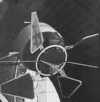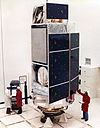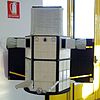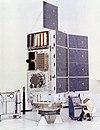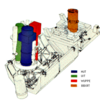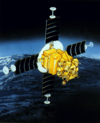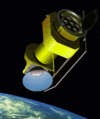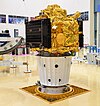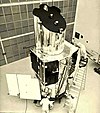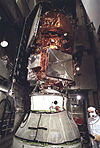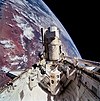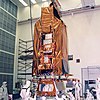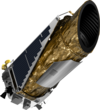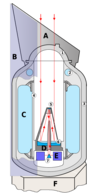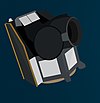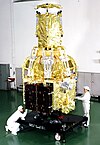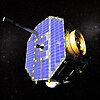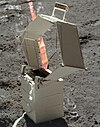
The Explorers program is a NASA exploration program that provides flight opportunities for physics, geophysics, heliophysics, and astrophysics investigations from space. Launched in 1958, Explorer 1 was the first spacecraft of the United States to achieve orbit. Over 90 space missions have been launched since. Starting with Explorer 6, it has been operated by NASA, with regular collaboration with a variety of other institutions, including many international partners.
Luna 14 was an uncrewed space mission of the Luna program run by the Soviet Union. It was also called Lunik 14.

The Compton Gamma Ray Observatory (CGRO) was a space observatory detecting photons with energies from 20 keV to 30 GeV, in Earth orbit from 1991 to 2000. The observatory featured four main telescopes in one spacecraft, covering X-rays and gamma rays, including various specialized sub-instruments and detectors. Following 14 years of effort, the observatory was launched from Space Shuttle Atlantis during STS-37 on April 5, 1991, and operated until its deorbit on June 4, 2000. It was deployed in low Earth orbit at 450 km (280 mi) to avoid the Van Allen radiation belt. It was the heaviest astrophysical payload ever flown at that time at 16,300 kilograms (35,900 lb).

The Herschel Space Observatory was a space observatory built and operated by the European Space Agency (ESA). It was active from 2009 to 2013, and was the largest infrared telescope ever launched until the launch of the James Webb Space Telescope in 2021. Herschel carries a 3.5-metre (11.5 ft) mirror and instruments sensitive to the far infrared and submillimetre wavebands (55–672 µm). Herschel was the fourth and final cornerstone mission in the Horizon 2000 programme, following SOHO/Cluster II, XMM-Newton and Rosetta.

Ōsumi was the first Japanese satellite put into orbit. It was launched on February 11, 1970 at 04:25 UTC with a Lambda 4S-5 rocket from Uchinoura Space Center by Institute of Space and Aeronautical Science, University of Tokyo, now part of the Japan Aerospace Exploration Agency (JAXA). Japan became the fourth nation after the USSR, United States and France to release an artificial satellite into successful orbit on its own. The satellite was named after the Ōsumi Peninsula in Kagoshima Prefecture, Japan, where the launch site was located.
The Constellation-X Observatory was a mission concept for an X-ray space observatory to be operated by NASA; in 2008 it was merged with ESA and JAXA efforts in the same direction to produce the International X-ray Observatory project, announced on 24 July 2008.
This is a timeline of space exploration which includes notable achievements, first accomplishments and milestones in humanity's exploration of outer space.
XEUS was a space observatory plan developed by the European Space Agency (ESA) as a successor to the successful XMM-Newton X-ray satellite telescope. It was merged to the International X-ray Observatory (IXO) around 2008, but as that project ran into issues in 2011, the ESA component was forked off into Advanced Telescope for High Energy Astrophysics (Athena).
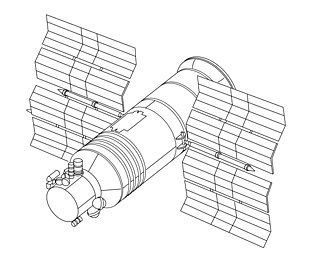
Gamma was a Soviet gamma ray telescope. It was launched on 11 July 1990 into an orbit around Earth with a height of 375 km and an inclination of 51.6 degrees. It lasted for around 2 years. On board the mission were three telescopes, all of which could be pointed at the same source. The project was a joint Soviet-French project.
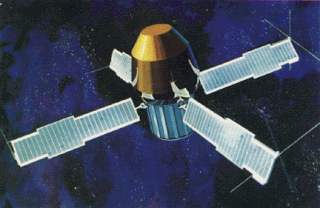
The Small Astronomy Satellite 2, also known also as SAS-2, SAS B or Explorer 48, was a NASA gamma ray telescope. It was launched on 15 November 1972 into the low Earth orbit with a periapsis of 443 km and an apoapsis of 632 km. It completed its observations on 8 June 1973.

The Astronomical Netherlands Satellite was a space-based X-ray and ultraviolet telescope. It was launched into Earth orbit on 30 August 1974 at 14:07:39 UTC in a Scout rocket from Vandenberg Air Force Base, United States. The mission ran for 20 months until June 1976, and was jointly funded by the Netherlands Institute for Space Research (NIVR) and NASA. ANS was the first Dutch satellite, and the Main Belt asteroid 9996 ANS was named after it. ANS reentered Earth's atmosphere on June 14, 1977.

A Broadband Imaging X-ray All-sky Survey, or ABRIXAS, was a space-based German X-ray telescope. It was launched on 28 April 1999 in a Kosmos-3M launch vehicle from Kapustin Yar, Russia, into Earth orbit. The orbit had a periapsis of 549.0 kilometres (341.1 mi), an apoapsis of 598.0 kilometres (371.6 mi), an inclination of 48.0° and an eccentricity of 0.00352, giving it a period of 96 minutes.
The (Japanese) Lunar Exploration Program is a program of robotic and human missions to the Moon undertaken by the Japanese Aerospace Exploration Agency (JAXA) and its division, the Institute of Space and Astronautical Science (ISAS). It is also one of the three major enterprises of the JAXA Space Exploration Center (JSPEC). The main goal of the program is "to elucidate the origin and evolution of the Moon and utilize the Moon in the future".
Cosmic Vision is the third campaign of space science and space exploration missions in the Science Programme of the European Space Agency (ESA). Formulated in 2005 as Cosmic Vision: Space Science for Europe 2015–2025, the campaign succeeded the Horizon 2000 Plus campaign and envisioned a number of missions in the fields of astronomy and solar system exploration beyond 2015. Ten missions across four funding categories are planned to be launched under Cosmic Vision, with the first being CHEOPS in December 2019. A mission to the Galilean moons (JUICE), the first deep space mission with an opportunistic target, and one of the first gravitational-wave space observatories (LISA), are planned for launch as part of the Cosmic Vision campaign.



